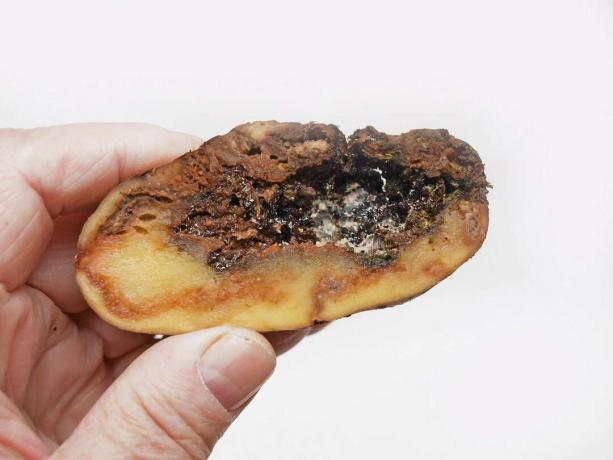Wireworms are up to mischief in the garden, in fields and even in forests and can be fatal to any gardener.

Most of us have seen the damage caused by wireworms and many have encountered wireworms in the garden. Neither the potatoes nor the salad are safe from him. You can find out what this strange-looking, tough worm is all about in our article here.
Contents
- Wireworm: A short profile
- Recognize wireworm: harmful image
- Wireworm on potatoes, salad and Co.
-
Successfully combat wireworm
- Fight wireworm with pesticides
- Fight wireworm naturally
- Attention risk of confusion
Wireworm: A short profile
When we talk about wireworms, we actually mean the large family of click beetles (Elateridae). The click beetle family includes a wide variety of small beetles whose larvae cause major damage to the underground parts of plants. The click beetles themselves do not cause any damage, they only feed on pollen and nectar.
The different species are difficult to distinguish, but you will often find the following species in your garden:
- Click beetles or field humus click beetles (Agriotes lineatus)
- Gloomy Hummus Click Beetle (Agriotes obscurus)
- lettuce click beetle (Agriotes sputator)
The adult beetles are dark in color and 9 to 12 mm in size. They are elongated and their slender body shape tapers backwards.

The wireworms have a yellowish-orange body color and can grow up to 2.5 cm long. They have a hard chitin shell, to which they owe their name. They have a multi-year development in the soil and feed polyphagous, which means that they have a wide range of food.
You will learn how the beetles and larvae develop in the next section.
The Wireworm Life Cycle
The click beetles lay their eggs in the ground in May or June. A female can lay up to 200 eggs in her lifetime. The clusters are found in flocks in the ground - not evenly distributed over the entire area. The wireworms hatch after about 4 to 5 weeks. This duration can be influenced by the weather. After that, the wireworms stay in the ground for up to five years and are up to mischief. During this time, they can go through between 9 and 15 larval stages, depending on the species. From the second year of life, the wireworms cause damage through their food. The larvae pass through up to three in early April to mid-May, late June to mid-July and from mid-August to early October. If there is a lack of suitable food, the wireworms can survive for up to a year without food, but then they retreat to deeper soil layers. But even when there is a drought, the larvae often retreat to deeper areas because they are very sensitive to drought.

A crucial factor in wireworm is the soil. In general, it prefers to be found on compacted and moist soil, since the females need such undisturbed areas to lay their eggs. Our meadows are particularly suitable for this.
But how does the wireworm find its way to the plant parts in the soil?
The wireworm uses CO to orient itself in the soil2. Like humans, plants and their roots also emit CO2 so that the wireworm is attracted to the breathable roots.
Recognize wireworm: harmful image
A typical symptom of soil pests is wilt. The wireworm eats at the roots of our beloved plants and as a result they can no longer absorb enough water and nutrients. As a result, the plants begin to wither. If you then dig them up, you can see the eaten roots. The wireworms gnaw at the roots or eat them off completely. At salads the wireworm is also often found in the root neck.

Both potatoes (Solanum tuberosum) can be found in the tubers feeding tunnels into the interior. The size of the tunnels varies depending on the developmental stage of the wireworm. The brown excrement of the wireworms can often be found in the tunnels. If the infestation occurs in the spring, the wireworms will eat the young sprouts. This weakens the plants so that they sometimes even fall off completely.
To get to the bottom of the infestation, you can use a few monitoring methods: First, of course, you can dig through the soil and check if there are wireworms in your garden. Another method of surveillance is the decoy method. Lay out sliced potato halves. Dig them about 10 cm deep, mark the spot and check a week later if wireworms have crept into your potato halves.

Wireworm on potatoes, salad and Co.
You're already looking forward to the potato harvest and what do you find after the tedious digging? Punctured and unappetizing potato tubers. So that this does not happen to you, we will briefly explain here what you can do against the wireworm.
Can you still eat potatoes with wireworm infestation?
When the wireworms have drilled into the tubers of the potatoes, these passages then cork up. In addition, there is often feces in the boreholes. A major problem is the risk of secondary infections. This damage allows bacteria and fungi to enter and infect the potato tubers. So if you have a punctured potato whose burrows have turned black (infested with fungi or bacteria), it is better not to eat those potatoes again.

Successfully combat wireworm
Fighting wireworms is a task that cannot be completed overnight. In the following section, we will show you several methods on how to deal with the annoying worm.
Fight wireworm with pesticides
At the moment, no chemical pesticides are approved against wireworms, so other methods of combating them must be used. There are experiments with the soil fungus metarhizium, which infests and kills the wireworms. But you can also get at the wireworm with natural measures. You can find out how to do this in the next section.
Fight wireworm naturally
As mentioned before, the females need dense and undisturbed soil for egg laying and the larvae are very sensitive to drought. We can take advantage of these properties.
- Keep soil dry and disturb wireworms
Tillage is an important key point. This can reduce the number of wireworms in the soil. By poking around in spring and/or autumn, you can disturb the annoying larvae of the click beetles and reduce the infestation somewhat. This can prevent egg laying, especially in spring. If you own a tiller, you should definitely use it to fight wireworms. Flushing is also a good way to remove moisture from the soil and dry out the larvae. So please don't overdo it with watering - especially during the feeding phases of the wireworms.

Find a healthy balance between the amount of water necessary for your plants to grow properly and the protection of the plants.
- Pay attention to the crop rotation
Crop rotation in the garden should also be a priority. This means that you don't want your vegetables to be in the same spot every year. Certain plants are more likely to be attacked by wireworms than others. Therefore, one should alternate with such plants. This includes potatoes in particular - since the wireworms from the emitted CO2 of the roots are attracted, plants with a large root system tend to be attacked.
- Expose healthy and strong plants
In terms of culture, we can also do a few things. Pre-germinate your plants before planting them out. Thus, the plants already have a head start in development and are placed in warmer soil. Healthy and strong plants are a good starting point for pest control. Using calcium cyanamide as fertilizer can reduce infestation by an estimated 20 to 30%.

- Harvest early
In the Potato Harvest it is important to do this as early as possible. The longer we leave the tubers in the ground, the more time the wireworms have to burrow into the potatoes. Precocious potato varieties could also help here. Here you can find more information about the best precocious potato varieties.
- use nematodes
The use of nematodes can also promise success with wireworms. The nematodes are easy to spread and search for their hosts in the soil. How you die Nematodes as beneficial insects use it correctly, you can find out here.
- Sow marigolds and marigolds
Wireworms can also be combated with special plants, which even add beauty to our garden. marigolds (Calendula officinalis) and marigolds (Tagetes patula) have a deterrent effect on the wireworms. Simply sow the beautiful flowers between your vegetables, admire the beautiful blooms and enjoy the effect. In addition, the marigold is a popular medicinal plant and sows itself. So next summer she will pop up in your garden all by herself.

The best methods for controlling wireworm summarized:
- Keep the soil dry and loose
- prefer plants
- Use early-ripening varieties
- Harvest early
- Mixed cultures with marigold and marigold
Attention risk of confusion
In order to choose the right control, it is important to correctly interpret the symptoms on the plants. There can be confusion with the potato. Dry core - recognizable by small grayish dots on the tuber surface - looks similar to wireworm damage, but is caused by the fungus Rhizoctonia.

What you should know about this fungus and how to Avoid and control Rhizoctonia you can find out in this article.
Register now for the Garten-Post and receive great tips, seasonal trends and inspiration on everything to do with the garden from our expert every week.



